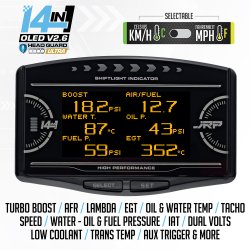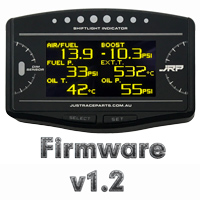 Wideband AFR Lean Out Warning Added
Wideband AFR Lean Out Warning Added
While there has been only one feature added in this latest firmware, it’s a big one. This latest firmware which all stocks are now shipping with has had a wideband AFR lean out warning added to the gauges, in our opinion this is really a big deal and takes the whole warning system on these gauges to another level and further improves on what was already an incredibly great warning system. For those that are looking to buy one of the multi gauge kits and also planned on buying the Spartan 2 wideband we sell to use in conjunction with it, or have an existing wideband that supports an analog output of 0-5v with a scale of 10-20 AFR which you can also run into these gauges, this feature itself will be a really big deal.
In short, what this feature is going to allow, is to setup a warning on the gauge so that if at any time your air fuel ratios run leaner than what they should be under boost, or wide open throttle conditions on an NA, the gauge can alert you quickly there is a problem. Below we run through the 3 different settings used to configure the wideband lean out warning and what they do, along with a couple of working examples of the warning function setup and the expected outcome.
Let’s face it, while we all periodically stare at our various gauges from time to time when driving, some more than others, if your car suddenly goes from running its tuned 11.5 AFR to 14.5 AFR when running boost, it would not take long before some pretty catastrophic detonation could occur. This is not something you really want to leave up to human detection, the time frame where engine damage could occur from a situation like this is far too short. So having a wideband lean out warning such as this, could very well help you catch a situation within seconds where something went wrong with your fuel system and you suddenly started to run extremely dangerous air fuel ratios for your motor.
So let’s jump right in and explain the parameters used to setup the warning and what they do, along with a couple of working examples of the warning function once setup.
 Air Fuel Boost Limit Setting
Air Fuel Boost Limit Setting
This is the first setting that you need to configure to setup the gauges air fuel ratio lean out warning, note its name can be deceiving, this feature can also be used on cars that are naturally aspirated as well, and we will show an example of that below.
For a wideband AFR lean out warning to possible, you need to also measure manifold pressure at the same time as air fuel ratio’s, this setting is used by the gauge to calculate when the warning should be active relative to manifold pressure. For this warning feature to function, you will need to have installed the supplied boost / map sensor in the kits.
So for example, on a car running 18psi of boost, you would want to set this setting at 15psi for example, once this is done, it means that the wideband lean out warning is only active when the car is at 15psi of boost or above.
One of the main reasons to set the boost limit setting a few psi below the actual boost pressure your car runs is, let’s say your car runs 18psi of boost, but in the upper rpm you sometimes get a bit of boost drop, you want to make sure that you are accounting for any drops in boost so that the air fuel lean out warning will still be active even when you might hit a slight boost drop in the upper rpm.
Now for naturally aspirated cars, it’s possible to set this value as vacuum, so for a NA car, you would set this to say -3psi (80kpa) for example.
Note: This setting has a selectable range of between -3psi (80kpa) to 25psi.
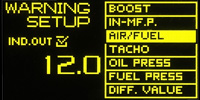 Air Fuel Warning Setting
Air Fuel Warning Setting
This is where you now set the air fuel ratio value itself you want used for the warning, if the gauge reads a higher AFR number than the one set here while also reading a higher manifold pressure than the number set for the Air Fuel Boost Limit Warning we covered above, then this is when the alarm will be triggered.
So let’s say we are running 18psi of boost on our car, the Air Fuel Boost Limit above has been set to 15psi and your car has been tuned to run between 11.7 to 11.5 AFR’s while pushing 15 to 18psi of boost. You would now set this value to the highest AFR you would want to see before a warning is triggered, so for this example below for a turbo or supercharged car, let’s select 12.0 AFR for this setting.
Now for a naturally aspirated car, which has been tuned to run 13.0 AFR when wide open throttle, for the NA example we will set this one to 13.5
Note: This setting has a selectable range of between 11.0 to 13.5 AFR
 Air Fuel Time Delay Setting
Air Fuel Time Delay Setting
This is the last step in setting up your wideband AFR lean out warning, what this setting does is add a time delay to the warning system so that once both conditions from the two settings above have been met, the car is at 15psi of boost or above, AFR’s have gone above 12.0, there will be a time delay before the warning will trigger.
This can be set from 0sec to 5sec depending on your vehicle. The reason there is a time delay is because you don’t want the alarm going off when changing gears etc, in certain circumstances the above two conditions could be met when not in a wide open throttle condition, so by adding a small time delay to the warning, you will stop the chance of any false triggers of the warning, in most cases a 1sec to 2sec time delay will suffice, so for the two examples below, we will set this one to 2sec.
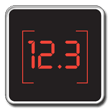 Example Warning On Forced Induction Car
Example Warning On Forced Induction Car
Ok, so now we have explained what each of the settings do for the air fuel ratio lean out warning above, here is a working example of how it will function on a turbo or supercharged car.
Now with the warning system configured as per the settings listed below and explained above, at any time the car is running over 15psi of boost, and the air fuel ratios go above 12.0, after a 2 second delay of those two conditions being met, the wideband warning will trigger to let you know you are now running lean and you can stop and investigate what has caused this.
When an AFR lean warning has been triggered, the gauge will highlight the air fuel ratio readout on the screen to indicate the warning has triggered, along with the unit making a loud warning beep to attract your attention. Note this warning function also supports outputting to the add-on cannon style external warning lights we also sell for the kits, while not totally necessary, some customers like the external warning lights as they can place them directly in their field of vision.
(Settings Selected For AFR Lean Warning)
Air Fuel Boost Limit: 15psi
Air Fuel Warning: 12.0
Air Fuel Time Delay: 2sec
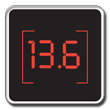 Example Warning On Naturally Aspirated Car
Example Warning On Naturally Aspirated Car
Now for a naturally aspirated vehicle, it’s a similar setup, but because they don’t run boost, you need to set the Air Fuel Boost Limit setting with a negative manifold pressure when talking in PSI, or vacuum levels if talking KPA such as 80kpa.
Now with the warning system configured as per the settings listed below and explained above to suit a naturally aspirated car, at any time the car is in a wide open throttle condition where manifold pressures are at -3psi (80kpa) or above, and the air fuel ratios being read by the gauge exceed 13.5, after a 2-second delay of those two conditions being met, the gauge will now sound a warning to alert you the car has been running lean and you can stop to investigate.
When an AFR lean warning has been triggered, the gauge will highlight the air fuel ratio readout on the screen to indicate the warning has triggered, along with the unit making a loud warning beep to attract your attention. Note this warning function also supports outputting to the add-on cannon style external warning lights we also sell for the kits, while not totally necessary, some customers like the external warning lights as they can place them directly in their field of vision.
(Settings Selected For AFR Lean Warning)
Air Fuel Boost Limit: -3psi
Air Fuel Warning: 13.5
Air Fuel Time Delay: 2sec
 Diagnosing Air Fuel Ratio Issues
Diagnosing Air Fuel Ratio Issues
There can be a number of causes for air fuel ratios to suddenly change, everything from a dying fuel pump, insufficient power being supplied to the pump, issues with fuel pressure regulators to name a few, but the first port of call is to confirm there may have been changes in fuel pressure. This is why when we sell these kits we highly recommend the fuel pressure sensors also be installed, as once they have been installed, you not only have a fuel pressure readout, but can also take advantage of the differential pressure readout on the gauge as well.
Diagnosing a sudden and unexpected issue with air fuel ratios really needs to start with checking the fuel system and getting some data, with the fuel pressure sensor installed from these kits, you can check to see if there has been any major changes in fuel pressure to what is normal, and to make that even simpler on return style fuel systems, the differential pressure readout works in such a way it’s very easy and clear to see if the fuel system is operating normally or not.
So while these gauges are terrific when installed into fully functioning cars to help you monitor and throw warnings if it sees a problem, they can also come in very handy when things go wrong, and help give you or your mechanic the data needed to help in the diagnosis of a problem that has arisen.

